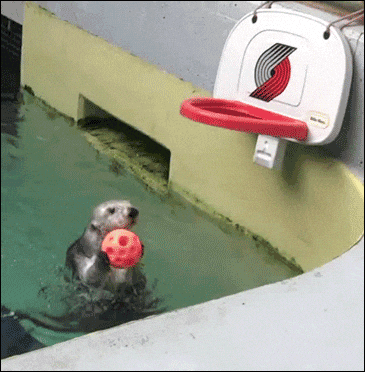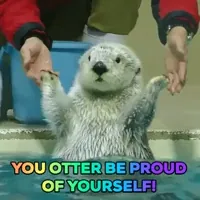
Welcome back to yet another week of learning about kelp! As mentioned last week this week is a surprise topic! It is about the symbiotic relationship between kelp and sea otters! Sea otters one may say but yes! Sea otters help protect kelp from degrading due to sea urchins! The kelp forest is home to many different species and provides a nurturing ground for fish. Kelp drifts away from the kelp plant which is what the sea urchins eat. Sea otters eat these sea urchins which maintains the equilibrium in the kelp forest. This allows kelp to develop in dense populations and provide sea otters with protection. Due to this relationship, sea otters are considered a keystone species for kelp forests. https://sciencing.com/symbiotic-relationships-kelp-forest-ecosystem-7273.html
Recent studies have discovered how sea otters can help with kelp. Kelp is very important in releasing oxygen into the air. They take carbon dioxide and turn it into carbohydrates for nutrients using sunlight and water and release oxygen to the air as a byproduct. New studies have shown that otters have increased the storage of carbon in kelp by “4.4 to 8.7 megatons.” The conclusion from these studies was determined to be that sea otters are not just important to the kelp forest itself but also to the environment itself! https://seaotters.com/2012/09/thanks-to-sea-otters-kelp-forests-absorb-vast-amounts-of-co2/
As mentioned above otters have an tremendous effect of kelp forest and the environment itself! Sadly, there are many threats out for sea otters. Some are due to humans, but some are also due to animals themselves. Threats include oil spills, shark attacks, bad fishing techniques, and habitat degradation. Oil spills are a human caused threat that happens due to offshore drilling. The oil effects the fur of the sea otter which helps with insulating their bodies. This can lead to death of the sea otters which could cause the increase of sea urchins and the demolition of kelp forests. Another threat is shark attacks. This is both humans caused, and nature caused because humans are destructing their environment making the sea otters move farther out so shark attacks are more prone to happen which lead to the otters death. A third cause is bad fishing techniques. Now a day’s fishermen are using larger nets to catch more fish, but as grabbing the fish, they are getting sea otters as byproducts that are also caught and killed. The last problem is habitat degradation. This can be caused by runoffs or by construction near their environments. The runoffs bring bacteria into the waters which could cause diseases within the otters. Construction destructs the environment of the sea otters. https://defenders.org/sea-otter/threats

https://www.google.com/url?sa=i&source=images&cd=&cad=rja&uact=8&ved=2ahUKEwjDiZKd5OnhAhVHTd8KHXK5BSYQjRx6BAgBEAU&url=https%3A%2F%2Fsoundwaves.usgs.gov%2F2004%2F07%2Ffieldwork2.html&psig=AOvVaw3_XYDmoa1DOUDdN5rAN2-J&ust=1556231420561131
Due to all the reasons above, severe kelp deforestation can occur. This not only impacts the kelp but also all of the species in the kelp forest are impacted. The whole equilibrium of food chain messes up. The organisms that eat kelp such as sea urchins, crustaceans, and snails would decrease due to the decrease in their food supply. This would cause the organism that eats them to die such as sea otters and sea lions. This would cause the predator of these animals to die which can be killer whales. Even just the decline of sea otters would cause the food web equilibrium to be disturbed. There are ways to protect this from happening such as stopping marine pollution, reducing the amount of runoff, new regulations of fishing which would limit the number of otters killed, and lastly developing new techniques in preventing oil spills from occurring which would protect the sea otters. https://soundwaves.usgs.gov/2008/11/research.html

https://www.google.com/url?sa=i&source=images&cd=&cad=rja&uact=8&ved=2ahUKEwj-0eHl4-nhAhXLY98KHdV5Ak4QjRx6BAgBEAU&url=https%3A%2F%2Fseaotters.com%2F2013%2F05%2Fwhy-are-sea-otters-important-no-sea-otters-no-kelp-forests%2F&psig=AOvVaw3IjDFLoJxp6lxCMBt_OROM&ust=1556231373494574

https://i.pinimg.com/originals/78/f3/fc/78f3fcfd9a2836565a1e37045e4a32a7.jpg
This is the final chapter of our journey in learning about kelp. There is much more information out there about kelp and the influence it has in medicine and the industrial world! As mentioned in a post before it can be used for anti-inflammatories! Thank you for joining the journey of kelp forest! I will leave you with one last fact to think about: kelp forests provide food and shelter for over 1000 plants and animals! https://www.nps.gov/subjects/oceans/kelp-forests.htm


Upasana,
I loved your blog post!! You provided great examples of the symbioses between sea otters and kelp forests. I never knew that sea otters ate those pointy, scary looking sea urchins. Speaking of, sea urchins are an expensive delicacy in many countries! It’s really interesting to see how depletion of one species can lead to a domino effect and basically create an imbalance in the entire ecosystem. People really need to understand the detrimental impact that can occur from malpractice and carelessness!
-Simi P.
Hey Upasana!!!
Otters are my FAVORITE animal, so this post made my day. It made me really sad thinking about sea otter endangerment though. We need to do better. My last post was also on how our Earth is suffering because we need to do better. Funny how both organisms came to that. I enjoyed reading this!!!!
Thanks for all the information on sea otters. I never knew the relationship to kelp let alone the environment.